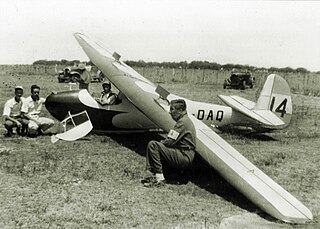Related Research Articles

The Abbott-Baynes Scud 1 was a parasol-winged single seat glider intended to introduce pilots to soaring flight. It was built in the United Kingdom and first flew in 1931.
The Hick Merlin was a high performance small sailplane built in the United Kingdom in the mid-1930s. It was a wooden, single seat, parasol wing aircraft. Only one was built.
The Latimer-Needham Albatross was the first British-designed and constructed sailplane, flying in 1930. Only one example of this single-seat, wooden aircraft was built.

The Manuel Crested and Willow Wrens formed a series of wooden, single-seat gliders designed in the UK by W. L. Manuel in the early 1930s, intended for slope soaring. Some were built by the designer, others from plans he supplied. The Dunstable Kestrel was a further development.
The Penrose Pegasus was a 1930s high-wing, single-seat, wooden glider from the UK. Designed, built and flown by Harald Penrose until the start of World War II, only one was built at the time though a reproduction was constructed in the 1990s.
The Czerwiński-Shenstone Harbinger, aka the Shenstone-Czerwiński Harbinger or the Shenstone Harbinger was a Canadian high performance tandem seat sailplane designed in Canada. Only two were built, one in the UK and one in Canada. The latter did not fly until 1975, being under construction for 26 years; the former remained active until at least 1994.
The CVV1 Pinguino was a single seat, high performance glider designed and built in Italy in the mid-1930s, the first of a series of gliders from the Milan Polytechnic. It did not go into production.
The CVV 2 Asiago is a simple, single seat glider designed and built in Italy in the mid-1930s, the second of a series of gliders from the Milan Polytechnic and the first go into production.
The CVV 3 Arcore was a single seat competition glider designed and built in Italy in the late 1930s, a development of the CVV 1 Pinguino. It participated in several national gliding competitions in the short period before the outbreak of World War II.

The DFS Rhönsperber, otherwise known as the Schweyer Rhönsperber or Jacobs Rhönsperber was a single seat competition glider designed in Germany by Hans Jacobs and first flown in 1935. For several years it was regarded as the best German sailplane and about one hundred were built.

The Schleicher Rhönbussard, otherwise known as the DFS Rhönbussard was intended as an intermediate glider trainer which could also fly competitively. It was designed by Hans Jacobs in Germany in the early 1930s. More than 200 were built.
The Bonomi BS.19 Alca was a single seat, tractor configuration motor glider, designed and built in Italy shortly before World War II. It had an unusual retractable undercarriage used only for take-offs. Only one was built.
The Sala N1 or N1 Sala was a single-seat,18 m span competition glider built in Italy in 1933. Only one was constructed.
The Teichfuss Gabbiano was an Italian, one-off, single seat, high performance glider, designed by Luigi Teichfuss and flown in 1928.
The Teichfuss Orione was an Italian high performance single seat glider, designed by Luigi Teichfuss. It made a six-hour record flight and also flew as the Italian representative at the 1936 Olympics.

The RRG Fafnir, named after the legendary dragon, was a single seat German high performance glider designed by Alexander Lippisch. It won the Rhön competition in 1931 and made several outstanding flights as well as setting a fashion for gull wings.

The Oberlerchner Mg 19 Steinadler is an Erwin Musger designed two seat tandem trainer glider built in Austria and first flown in 1951. Several examples of this successful aircraft, which competed in the two seat class at two World Gliding Championships in the 1950s, were still flying in 2000.

Lore and a copy, Musterle, were high performance sailplanes designed at Darmstadt by Paul Laubenthal. Lore was flown successfully by the well known glider pilot Wolf Hirth at the 1929 Rhön (Wasserkuppe) glider competition. Musterle was used by Hirth used to demonstrate the possibilities of "blue sky" thermalling for the first time.
The Laubenthal Württemberg, sometimes known after its constructors as the Akaflieg Darmstadt Württemberg, was a single seat glider designed by Paul Laubenthal and built at the University of Darmstadt for Wolf Hirth, who won four prizes in it at an international competition in France in 1928. A second machine was built in 1929 by the Klemm Leichtflugzeugbau GmbH.

The Rubik R-03 Szittya I was a Hungarian single-seat sailplane flown in the late 1930s. The design was developed through three improving variants. though only one of each was built.